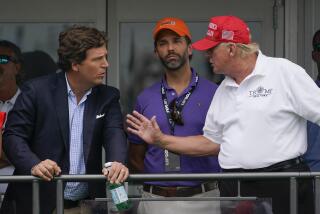I want my House TV
FOR MOST TV viewers, the House of Representatives on C-SPAN is about as appealing as an infomercial for juicers or wrinkle creams. That’s partly because any semblance of real debate on the House floor vanished years ago, replaced by scripted exchanges with occasional bursts of feigned emotion. But another problem is that the cameras are controlled by the speaker of the House. C-SPAN wants to change that.
This week, C-SPAN Chief Executive Brian Lamb asked incoming House Speaker Nancy Pelosi (D-San Francisco) to give viewers a more complete picture of the House floor. Citing Pelosi’s pledge for a more open House, he urged her to let C-SPAN bring its own cameras into the chamber, under its own direction. That way, viewers would get more of the flavor of the House and the personality of its members. They would be more likely to see such excitement as members’ reactions to provocative remarks, committee chairmen holding court in the back of the chamber and last-minute cajoling to win badly needed votes.
Lamb also wants immediate access to voting records. A giant electronic display board inside the chamber provides a real-time view of how individual members vote (and change their votes), but C-SPAN currently can show nothing but the total for each party until long after the tallying has ceased. It’s not unusual for the majority party’s leadership to extend the voting period while they woo holdouts, but unlike people watching from the gallery, C-SPAN viewers can’t tell who those holdouts might be.
The changes wouldn’t transform C-SPAN’s coverage into gripping drama or even “Survivor: Capitol Hill.” Nothing can do that, at least not since Congress put metal detectors at all the entrances to the Capitol. But they would add a needed dose of realism, which is why Pelosi is likely to turn Lamb down, just as incoming House Speaker Newt Gingrich (R-Ga.) did 12 years ago.
The House chamber may be open to the public, but only a predictable fraction of the activity there is broadcast across the country. Members who fly in on a red-eye know that they won’t be caught napping on the floor as long as they pick a seat away from the microphones.
Still, that’s no reason to put blinkers on the House cameras. The most notable time the cameras strayed off the member at the microphone was in 1984, when Gingrich and other Republican conservatives were blasting the Democratic leadership in speeches late in the day. House Speaker Thomas P. “Tip” O’Neill (D-Mass.) ordered that the cameras pan the empty chamber. The move, however partisan in motive, lifted the artifice that covers too much of the House’s work. It’s time again for the House to bring some reality to its TV.
More to Read
Get the L.A. Times Politics newsletter
Deeply reported insights into legislation, politics and policy from Sacramento, Washington and beyond. In your inbox three times per week.
You may occasionally receive promotional content from the Los Angeles Times.









